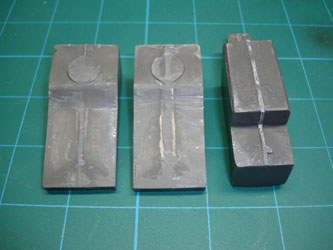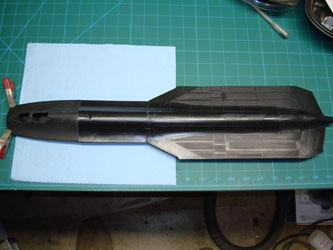
Testors 1/48 SR-71A Blackbird Build Review
By Michael Benolkin
| Date of Review | March 2020 | Manufacturer | Testors |
|---|---|---|---|
| Subject | SR-71A Blackbird | Scale | 1/48 |
| Kit Number | 584 | Primary Media | Styrene |
| Pros | Best kit of this subject in this scale (so far) | Cons | Only kit of this subject in this scale (so far) |
| Skill Level | Experienced | MSRP (USD) | Out of Production |
Build Review
For a brief background description of this subject and a look at this kit out of the box, look here.
We all have projects that have been on our 'bucket list' for years, and two of those are finally getting underway. I've had both the Testors 1/48 SR-71A/B and YF-12A kits in my stash for over 20 years, awaiting the day that I would have time and the aftermarket stuff to do these aircraft right. Tooled by Italeri back in the early 1980s, Testors was able to release the kits in their own boxes a few years later. To date, these are the best (and only) kits of either aircraft in this scale, but the cockpits, inlets and afterburner sections were not really well done. Modelcollect had announced that they were going to produce the single-seat and two-seat Blackbird family starting last year, but after the awful launch of their B-52s in 1/72, I'm not sure I'd buy another kit from them. The 'new' Revell has also announced a 1/48 SR-71A for next year, and I'm sure they'll do the subject right. Nevertheless, I suddenly had the urge to get these two birds going now that all of the elements I need are finally available.
Way back when, True Details (Squadron) produced a decent resin cockpit for the SR-71A as well as a set of resin wheels. Of course, I stashed these into the project boxes. Cutting Edge (Meteor Productions) produced a beautiful resin afterburner section for the kits, but alas, I was only able to acquire one before Meteor closed. That too was put away though I wondered which project would get the resin set. Cutting Edge also released some nice decals for the SR-71 at about the same time (right before they closed). Fast forward a decade or so, and some new resources have come along. Metallic Details produces several updates for the SR-71 kit including new resin wheel wells/landing gear details, new resin inlets with some impressive shock cones, new resin nose/radome for the SR-71, and a photo-etched set to fix/update the afterburner sections as well as replicate the various vents/grills around the airframe. Finally, Caracal Models released some really nice decal sets for the SR-71 and YF-12. It was clearly time to get these projects off the ground (so to speak).
The first step in this project is deciding whether you're building the SR-71A or B. Since I had the YF-12 kit, another option was the SR-71C. The forward fuselage has an insert that fits around/behind the front cockpit that either has the rear cockpit at the same level as the front (SR-71A) or a raised rear cockpit (SR-71B/C). In the first photo, I've fitted the A-model insert and cleaned up the parts to get a good snug fit. Once I was happy with the fit, I used Tamiya Extra Thin Cement to glue the parts together followed by some 3M acrylic putty to fill in the resulting seams.
I primed the cockpit tubs and interior sides of both forward fuselages before dry-fitting the tubs. While the fit of the tubs was good, the mold stubs under the tubs had to go - time for the big razor saw. I also used my fine razor saw to remove the instrument panel cover out of the front cockpit and replace it with the resin cover out of the True Details cockpit set. Since the red putty had shrunk (as expected), next came a layer of Mr. Surfacer 500.
The instrument panels and ejection seats were primed with black, and then began the detail painting of four tubs, four ejection seats, and four instrument panels. The putty/Mr.Surfacer applied to the seams on the forward fuselage was given a coating of cyano before being buffed smooth. I used Stynylrez black primer to check my work.
With the detail painting complete, it was time for one last test fit of both sets of cockpits before mounting them into place.
The rear instrument panel mounts into the upper fuselage section while the front panel mounts to the cockpit tub. Here we have both tubs installed into the SR-71 forward fuselage. I'll add the control sticks and ejection seats later in the process to make it easier to mask over the cockpit openings.
Next in the queue are the wheel wells. We're using the recent wheel well set from Metallic Details and this is my first opportunity to try one of their products out on my bench. Here's their resin nosewheel well replacement next to the kit's "flat" nosewheel well. The difference is dramatic. In these shots, I haven't added the various details inside the resin well yet, this exercise is about how the basic well fits inside the kit. I used my Alec Pro-25G fine razor saw to carefully remove the molded-on nosewheel well without damaging the lower fuselage. Using the Sujiborido file to plane the remaining material out of the way, I could see that the MD resin nosewheel well fits beautifully. When I was dry-fitting the upper and lower forward fuselage sections, I saw that the upper section needed to be propped up to get the edges to fit. When dry-fitting the MD nosewheel well inside the forward fuselage sections, the height of the well is exactly what is needed to get the right shape to close up the seams in the upper/lower halves.
Moving to the main wheel wells, the kit wells have much more depth to them than the kit's nosewheel well, but comparing these to the MD resin replacements, you can see several advantages including more/better details inside the wells, and the depth of the wells themselves. The walls of the main wheel wells molded into the lower fuselage section will need to be removed along with some other minor adjustments. With the new wells installed, the model is going to have a much stronger mid-section after assembly.
Looking at the MD wells, you can see there are mold seams that will need to be removed from the main wheel wells in order to get a perfect fit. I've started that process, but a little more work is required. The seam on the nosewheel well is not critical as it doesn't come in contact with the upper fuselage, the upper sides of the well will rest against the inside of the dorsal spine, providing more rigidity to the completed model.
I used cyano to install the nose and main wheel wells to the lower fuselage half and in this photo, I'm dry-fitting the upper main fuselage half to double-check the fit one last time before gluing the halves together.
Moving to the nose section again, the nosewheel well does indeed restore the right contour for the dorsal spine, but that's when I discovered the upper nose half no longer fits. You'll recall that the SR-71 kit offers the choice of the standard tandem cockpits of the SR-71A or the raised rear cockpit of the SR-71B. To facilitate those two inserts that make up the rear cockpit, there is a styrene bridge molded inside the upper nose half that retains the shape and strength of the part before/during assembly. I had to modify the upper nose half to remove that bridge which meant removing the resin cockpits and the previously puttied rear cockpit insert. The upper nose half of the SR-71 kit has a lip that fits under the main upper fuselage half, but that too had to be modified to fit around the nosewheel well. I rounded the edges of the resin nosewheel well to improve the fit as well.
Test-fitting the modified upper nose section finally reveals a smooth fit of the fuselage. Before I could glue the fuselage completely together, I inserted the viewports into the lower fuselage for the cameras, glued them into place, reinforced them with thick cyano, then took a sanding stick to the clear parts until they blended smoothly into the lower fuselage surface.
While I haven't buffed out the rough sanding yet, the modifications to the fuselage work nicely, next I'll reinstall the cockpits, glue that section to the fuselage and add the radome, which is also a resin improvement from Metallic Details. You can see here that the YF-12 nose fits over the nosewheel well with no modifications required.
So far, the wings dry-fit nicely into place, so once I wrap up the fuselage, it will be time to do the modifications to the intakes for the Metallic Details shock cones and afterburner section details. We're getting closer though it is taking a little longer than anticipated!
To be continued...






























